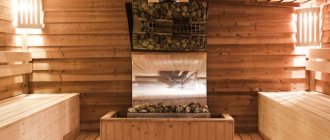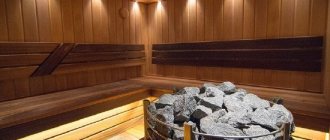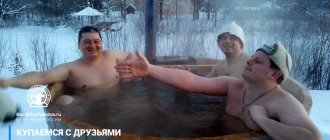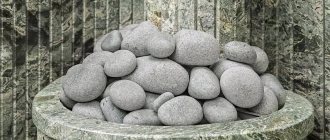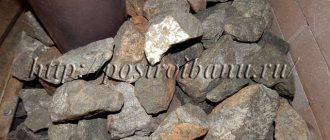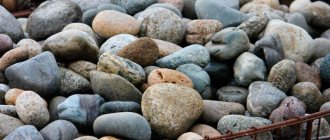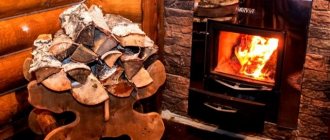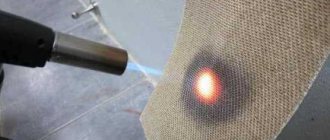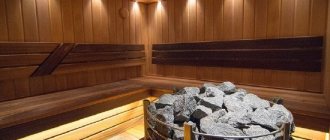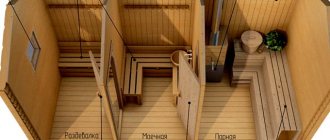Professionals know exactly what effect a heated mineral has on people when interacting with water. Below we will try to understand in more detail how to choose stones for a bath and how best to use them. And what’s most interesting is what stones for a bath can be collected completely free of charge in your area. Beginners will find it extremely useful, and professionals may pick up a couple of interesting ideas.
Stones for the heater
To fill the heater you need to use a variety of types of minerals. It doesn't matter whether you like them or not. Each of them has individual characteristics and unique properties. All stones for sauna stoves have their own unique feature.
Heat resistance. The mineral should not react to high temperature and temperature fluctuations.
They have to withstand heavy loads. They are first heated until the temperature reaches its maximum value. Then the stones are watered. The result is uneven cooling.
Not every mineral can withstand such tests. With a high value of the heat resistance coefficient, the mineral very rarely cracks, chipping is excluded.
Density. How high the density is can be easily checked using an ordinary hammer. You just need to hit its surface. The second option would be a hot stone doused with cold water. If after such tests it remains intact, then we can talk about its high quality. If a crack appears on the surface, it means that the heat resistance of the mineral is low.
Heat capacity. The ability of the mineral to store heat for a long period of time depends on this indicator. Bath attendants require that the stone heats up quickly and releases heat for a very long time.
Typically, such minerals are heavy and have a uniform structure. When the density is high and the rock is homogeneous, the effect of the steam room can be quite large. Such minerals warm up quickly. Their cooling continues for hours. They can easily withstand temperature changes.
Dimensions. When making a choice, you must always remember that the installed stove works well only with certain dimensions. Therefore, when choosing the right mineral, in addition to the aesthetic approach, you need to take into account the practical component. In wood-burning stoves, it is better to use stones with dimensions of 7–15 cm. Electric stoves will work perfectly with smaller minerals: 5–7 cm.
Environmental requirements. When the stone becomes very hot, it is possible to release toxic substances that can be harmful to human health. To prevent this from happening, you need to select only breeds specifically designed for use in the bathhouse.
The appearance of the mineral plays an important role. You definitely need to pay attention to this. The surface must be absolutely smooth and free from any inclusions or traces of impurities. This material is of high quality. They are completely safe for others.
If traces of mica are visible on the surface, combined with another rock, when heated, splitting and release of harmful substances is possible.
Classifications of bath breeds
Minerals for baths are divided into decorative (facing) and stove backfill (fillers). The first type of stones has low resistance to temperature changes. Amphibolite and coil (synonym – serpentinite) are suitable for finishing walls or stoves. But they cannot withstand hardening or contact with fire.
It is better to fill stoves in baths:
- nephritis;
- jadeite;
- jasper;
- chromite;
- quartz;
- cast iron;
- porcelain;
- rodingitis;
- soapstone;
- dunite;
- crimson quartzite;
- porphyrite;
- gabbro-diabase.
In Turkish hammams, stones are used to decorate walls, floors, and sun loungers. Rodingite is optimal for baths, as well as marble and all types of minerals recommended for steam rooms.
Resistance to high temperatures and changes
The thermal stability of mineral fills is checked regardless of the characteristics of the rock, since strength deteriorates due to internal defects. Before laying, the stones are heated, then lowered into a container of cold water. Cracked specimens are thrown away. It needs to be hardened 2-3 times.
Comparison of the best stove filling for baths:
| Types of bath stones | Melting point | Strength |
| Green jadeite | 1060ºC | Cracks with regular contact with fire (placed on top) |
| Raspberry quartzite embanked | Over 2500 ºC | Resistant to calcination |
| Gray gabbrodolerite | Withstands more than 250 calcination cycles | Fireproof |
Excessive heating of stones, improper placement and contact with open fire significantly reduce their service life.
Ability to retain heat
For a bath, the best stones are porphyrite, jadeite, and ceramic balls. Their heat capacity is more than 0.8 J/kg × K. Thermal conductivity reaches 3.6 W/m × K.
Dolerite (micro-gabbro) has a heat capacity of 0.85 kJ/kg × K, and a thermal conductivity of 1.7 W/m × K. Soapstone gives off heat throughout the day, but it must be changed frequently. The salt stone on the walls does not burn, warms up well, and remains warm for a long time.
By size
Large or medium-sized stones are suitable for a bath with an open stove (Finnish saunas, steam rooms). Minerals above 7 cm maintain the air temperature within 90–100 ºC for a long time.
Recommended backfill dimensions for other types of furnaces:
- wood-burning - stones 8–18 cm;
- electric furnaces - minerals with a fraction of 4–7 cm, cast iron balls with a diameter of 80 mm;
- closed heater - specimens less than 23 cm;
- metal or “cast iron” - cast iron products with a size smaller than the door opening.
The listed dimensions are suitable for stove fillers made of ceramic, porcelain or stainless steel.
On environmental safety
There are mineral rocks that accumulate radiation or contain sulfides and other harmful impurities. Dangerous samples include granite and specimens with colored inclusions. Uniformly colored jadeites, dunites, peridotites, as well as cast iron, food grade stainless steel, ceramics, and mullite-corundum porcelain are considered harmless.
Harmful substances are released:
- from creosote;
- splashes of red, gray, yellow, golden color;
- inclusions with a metallic sheen.
It is safer to use soapstone magnesite for the stove instead of soapstone chlorite. For wall decoration, cuts and bars of salt stones are considered the best. Hardened pieces of sea or Himalayan salt are purified from allergens.
For a bathhouse you cannot use paving stones or crushed stone near railway tracks. Store fills are considered safe. The product is certified and undergoes radio control.
What stones and where to collect for a bath
Not everyone goes to the store to buy bath stones. Some people prefer to collect them themselves. I would like to remind such people: the structure of the stone should be uniform. Layering and the presence of foreign particles are not allowed.
River stones are best suited for a bathhouse. Experienced bath attendants, collecting them themselves, recommend collecting minerals near clean mountain streams. But if you don’t live near the mountains, then an ordinary river will do. The best rocks are where the river makes a bend. Often in such places there is a choice of stones that can be used for a bath more. To test the strength of the found minerals, they are struck against each other.
The absence of fragments and other noticeable damage indicates the quality of the mineral. They are then heated to maximum temperature. The surface must remain clean without forming a film. No unpleasant odor emissions are allowed.
When the stones are heated to the limit, they are lowered into cold water. If they remain intact, then they can be put into the heater without fear.
The dimensions of the minerals should be within 10–15 cm. Sometimes they take 20 cm. Smaller stones are not suitable for use in a bathhouse. They are not able to accumulate the required amount of heat. Large ones will begin to burst quickly, since heating will not be uniform.
Bath attendants' advice
Bath stoves are allowed to be filled with several varieties. Minerals with the lowest heat capacity are placed at the bottom, then with the average value, and at the top - with the highest value.
- replace the mineral filler every 3–4 years (porcelain, cast iron and stainless steel products last for decades);
- soapstone is often washed from dust, calcined and washed again with water, dried;
- When selecting mineral backfill, you need to buy/collect samples with the least porosity and high specific gravity.
It is better to buy bath filling in stores. The product is tested for safety and treated against fungi and infections. They have a large assortment of minerals of different fractions. They also sell mixes: 2–5 types of stones in one package.
Porphyrite and similar rocks crack during the first calcination, then the sound disappears. If the cracking continues, the backfill must be changed.
The best stones for saunas and Russian baths:
| Oven type | Ideally | Recommended for backfilling | Suitable for use in baths/saunas |
| Boulders in contact with fire (Kuznetsov designs or periodic action) | Jade, cast iron, chromite | Porcelain balls, quartz | Varieties of dunite, soapstone, rodingite, porphyrite |
| Open heaters (minerals are doused with water) | Rodingite, quartz, jade | Jasper, jadeite, dunites | Chromite, gabbrodolerite, porphyrite, soapstone |
| Closed heaters, open bottom stoves | Porcelain, quartzite, cast iron grades SCh20, ChH16 | Jasper, quartz, rodingite | Dunites, jadeite, porphyrite, varieties of diabase, nephrite |
| Sauna stove (minerals are in contact with air: the top is open, the stones are held in place by a mesh around the structure) | Jasper, jade | Balls made of ceramics or porcelain, quartz, jadeite | Gabbrodolerite, rodingite, quartzite, dunites, chromite |
Natural minerals that do not contain harmful impurities are suitable for a Russian bath or Finnish sauna. There are many types of backfills and a wide price range. The cheapest of all is natural river boulder or sea pebbles. They cost from 10 rubles/1 kg.
In addition, watch a video about how to assemble a sauna stove yourself:
What backfills are used in your bathhouse? Comment on the article, share your experience and interesting filling options. Send information to friends on social networks. Best wishes.
Nice stones
If the stones are chosen correctly, they bring great benefits to the human body. When steaming occurs, some of the minerals contained in them turn into steam, which carries healing properties.
After numerous studies of various types, lists of the most beneficial stones for the body were compiled. Today the range is quite large and they can cure:
- Joints;
- Cold;
- Kidney diseases.
Jadeite contains the most useful substances. It includes:
- Calcium;
- Iron;
- Magnesium;
- Copper.
Moreover, the amount of such substances is considered the most optimal. When the heater is filled with jadeite, the air is filled with a large number of microelements. Hot steam turns into a kind of cocktail of useful substances.
Bookmark order
You have selected the largest specimens and are going to put them on the bottom. Their shape is arbitrary, often elongated to one side.
When installing, observe the following recommendations:
- Do not place oblong stones flat. It’s better to place them end-to-end, with the narrower side down. The rule is due to the greater speed of thermal energy propagation along the layers, and not across them. Another reason for this choice is the need for free passage of hot air between the stones. End masonry increases the number of gaps between specimens.
- In the bottom row you need to place rocks that will not quickly collapse from high temperatures. For example, it is a pity to put jadeite near the fire, because the stone is expensive, and such an arrangement will quickly crumble. For the bottom row, dunite, peridotite, and porphyrite are more suitable. These breeds are more adapted to high temperatures.
- After placing the first row, proceed to the second. Here, stones should also not be placed tightly. This is necessary for air circulation. Also, the distance between the stones is necessary to prevent destruction of the stove. The material expands when heated, and dense packing increases compression.
Number of stones
Of course, to obtain a healing effect, you need to know how many stones you need to put in the heater. This issue can be easily resolved. You need to read the instructions carefully.
For a self-made stove, a calculation is made, which is based on the volume of the steam room. 20 kg of minerals will correspond to one meter. Volume is calculated by multiplying the height by the length and width of the room.
Before putting stones into the heater, they are first washed and dried. Laying dry boulders is carried out in the following sequence:
- The largest ones are placed downwards;
- Small, creating a top layer.
When laying, you don’t have to make a very dense layer. When they are round in shape, it is very easy to place in the heater.
Chipped, poorly processed, laid leaving gaps. They are needed to create good air circulation.
Oblong ones are placed only in a vertical position. This makes it possible to create good circulation and uniform heating.
Electric ovens require special installation. If they are placed between heating elements, be sure to leave a gap. In case of thermal expansion, they will not be able to damage the heating elements. In electric ovens, it is very important to prevent water from getting on the surface of the heating elements. Therefore, only small stones are placed in such a stove, which will block water from entering this section of the stove.
Laying methods
There are 2 installation methods: open and closed. The quality of the resulting steam depends on the choice. The choice of one or the other depends on the type of oven and other circumstances.
But there are general rules:
- Large stones are laid down to form a base for small ones. The lower part of the heater is located closer to the firebox, and the temperature there is higher, and larger stones require more heat. If you place them on top, they will take a very long time to heat up. This will increase the preparation time for the bath and, accordingly, fuel consumption will increase.
- Leave space between the surfaces of the stones. There is a misconception that when laying open, it is not necessary to follow this rule, since this does not at all affect the heating process of the stones. There is logic in this, but there are other factors to consider. For example, when heated, stones will expand - depending on the rock, some more, others less. If there is not enough space between them, this will lead to the stones quickly cracking, and if the structure of the heater is not strong enough, it may become deformed and even collapse.
There are many nuances of installation, so when starting to solve the problem yourself, you need to carefully study all aspects of the topic.
Open backfill
It is used in baths that are heated “on white”, as well as in steam rooms with electric stoves.
With this method, exhaust gases do not pass through the stones, and heating occurs from the walls of the furnace.
The advantage of open backfill is that soot and soot do not settle on the stones and do not get into the steam.
- The disadvantage of this method is the slow heating of the heater. More firewood will be needed to achieve the desired temperature.
Important! In an open oven, you should not stack stones because the top stones will not heat up enough. It is correct to limit the height to the side of the heater.
Closed styling
In this method, the stones are placed above the firebox. The base is a cast iron grate or a slotted brick vault. The bottom layer heats up to 1000 degrees, so you need to choose the stone wisely. The breed must be resistant to such temperature effects.
The quality of the stone in a closed system is critical. Even minor defects during heating will separate from the main body, crumble and can clog the furnace roofs. This will result in the heater not heating up.
When laying closed, it is important not only to lay the stones correctly, but also to regularly check their condition and replace damaged elements.
Types of stones
Online stores and specialized outlets offer various types of bath stones. Don't focus only on price. Each has its own peculiarity.
Diabase for baths
Never sold whole. Its price is affordable. The high density of diabase does not allow for its processing. The stone can withstand 300 cycles of heating and rapid cooling. Another certified variety is gabbro-diabase.
Raspberry quartzite
The cost of this mineral is slightly higher. After heating, it begins to radiate a soft, pleasant warmth. The use of crimson quartzite has the following advantages:
- Increases immunity;
- Improves blood circulation;
- Normalizes metabolism;
- Relieves back pain;
- Normalizes blood pressure.
The stone is distinguished by its beautiful appearance and is designed for long-term use.
Jadeite in the bath
This is the most expensive mineral, considered the best for baths. In Eastern countries it was given the name “stone of health.” It is used for a variety of purposes:
- Treatments;
- Massage;
- Treatment of nervous diseases;
- Improved well-being.
When this rock begins to heat up, it begins to release large amounts of trace elements. After they enter the human body, the functioning of all vital systems is normalized.
When placing heater stones in a sauna, there is no prohibition on combining several types. For example, the bottom can be covered with a cheaper rock, and on top you can create a layer of beautiful and expensive ones.
When buying stones for a bath, it is difficult to answer which ones are better, without knowing what operating conditions you will have.
Why is it important to follow installation technology?
Stone stoves are able to accumulate thermal energy and gradually release it into the steam room atmosphere. Proper installation of the heater is the key to quick and high-quality heating.
A conventional stove for a Russian bath assumes uniform and gradual heating. The heating process is a lengthy operation. Active vaporization begins only after the fuel burns out. Proper installation can significantly reduce the time it takes to get the steam room into working condition.
In addition, properly laid material will retain heat and release it slowly. Therefore, you will have to put a new portion of firewood into the firebox much less often.
How to care for stone
The maintenance method depends on how intensively the steam room is used.
If the steam room is not used too often, the stones need to be sorted at least once a year. Instances with cracks and chips must be replaced. Sorting is performed in accordance with a certain sequence:
- All contents are removed from the container;
- Defects are identified;
- Cleaning in progress;
- Wash well;
- Dry.
Then it is sorted. You can use defective products to decorate a flower bed in the garden. They are great for decorating your own small pond.
Whole specimens, which can be safely reused, are washed and laid out on a metal mesh. It is watered with warm water. Transfer to the shade and dry for 3–5 hours.
The container location must be cleaned and inspected for defects. The completion of the work is considered to be the installation of the container, followed by the placement of stones. If a deficiency is identified after the work has been done, the quantity must be supplemented with new copies.
Possible installation errors
Violation of stone laying technology is a risk of improper air circulation and, as a result, poor heating of the room. You can also experience accelerated destruction of the material, and sometimes damage to the firebox itself.
Common mistakes of inexperienced bathhouse owners:
- Incorrect quantity selected . Insufficient number of elements will not produce enough steam. If there is more material than recommended, it will not be able to warm up well.
- Incorrectly selected breed and fraction size . Steam formation depends on the properties of the components, and the circulation of gases in the space between the stones depends on the size.
Sequence of work
After you have taken the stones out of the oven, you need a container in which you will wash them. You can use an old bathtub.
Fill the bathtub with water, put stones in it and soak for several hours. Then take out one stone at a time, scrub with a brush, and rinse in running water. Place them in the sun and let them dry.
If you use any powders as cleaning agents, rinse the stones thoroughly. Make sure that the cleaning agent does not remain in microcracks. When the stones dry in the sun, the defect in your work will be immediately visible.
Plaque will be visible on poorly washed stones. This means the stones need to be washed again.
What you need for work
To be honest, all work with the stove is the worst! Soot, soot, ash, coals - all this is difficult to wash and does not wash well. I advise you to prepare clothes that you don’t mind throwing away later. Thick rubber gloves are best for work.
It is also necessary to have a supply of new stones for the stove to replace those that you discard during the process.
Be sure to prepare a large tank in which you will place stones.
Stiff brushes will also come in handy. Some bath attendants use a variety of chemicals to clean stones to remove carbon deposits and scale. They even use diluted citric acid.
I am against using any chemicals in the bath, so I use simple river sand to clean the stones. A stiff brush, sand, running water - that's all I use to clean stones.
